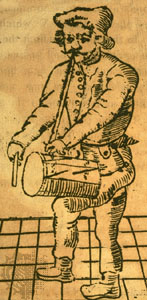The Grand Old Duke of York
"The Grand Old Duke of York" (aa gsunga ois The Noble Duke of York) is a englischa Kindlreim. Ea wead oft ois Äktschn Singspui im Ganslmarsch gsunga oda mid bstimmtn Gestn.
Es is a Spoddliadl und mocht se iwa an groussn Heazog lusti. Da Reim ironisiad sinnlosn Aktionismus, uaspringle woi a deppade militearische Aktion. Woarscheins beziagt si des Liadl af an bestimmtn historischn Heazog, af wejchan is owa umstriddn.
"The Grand Old Duke of York" is im Englischn heit zan stehadn Begriff fia hianlosn Aktionismus woarn.
Text
[Werkeln | Am Gwëntext werkeln]
Midm Higl is a Buagbeag gmoant. Da Heazog losst seine Leidl affe und owe maschian und wieda affe und owe oda losst se af howade Häh steh. Es fäid eam da Plan.
Da Uasprung vo dem Reim wead oft am Richard Tarlington zuagschriem. Am englischn Schauspuia und Hanswuascht ausm 16. Joarhundad.
Vo dem Liadl gibts an Haffa Variantn, d bekanntaste is:
Oh, the grand old Duke of York,
He had ten thousand men;
He marched them up to the top of the hill,
And he marched them down again.
When they were up, they were up,
And when they were down, they were down,
And when they were only halfway up,
They were neither up nor down.[1]
- Iwasezung
Mei, da große oide Heazog vo York,
Dea hod zehntausad Mona;
Es losst se en Higl affemaschian,
Und nache wieda owe maschian.
Wanns obn woarn, na woarns obn,
Und wanns untn woarn, na woarns untn,
Und wanns nua hoibad obn woarn,
Na woarns weda obn no untn.
Beleg
[Werkeln | Am Gwëntext werkeln]- ↑ I. Opie and P. Opie, The Oxford Dictionary of Nursery Rhymes (Oxford University Press, 1951, 2nd edn., 1997), pp. 442–443.
Im Netz
[Werkeln | Am Gwëntext werkeln]- The Grand Old Duke of York (Youtube - Animation)
- The Grand Old Duke of York (Youtube - Kindlspui)
